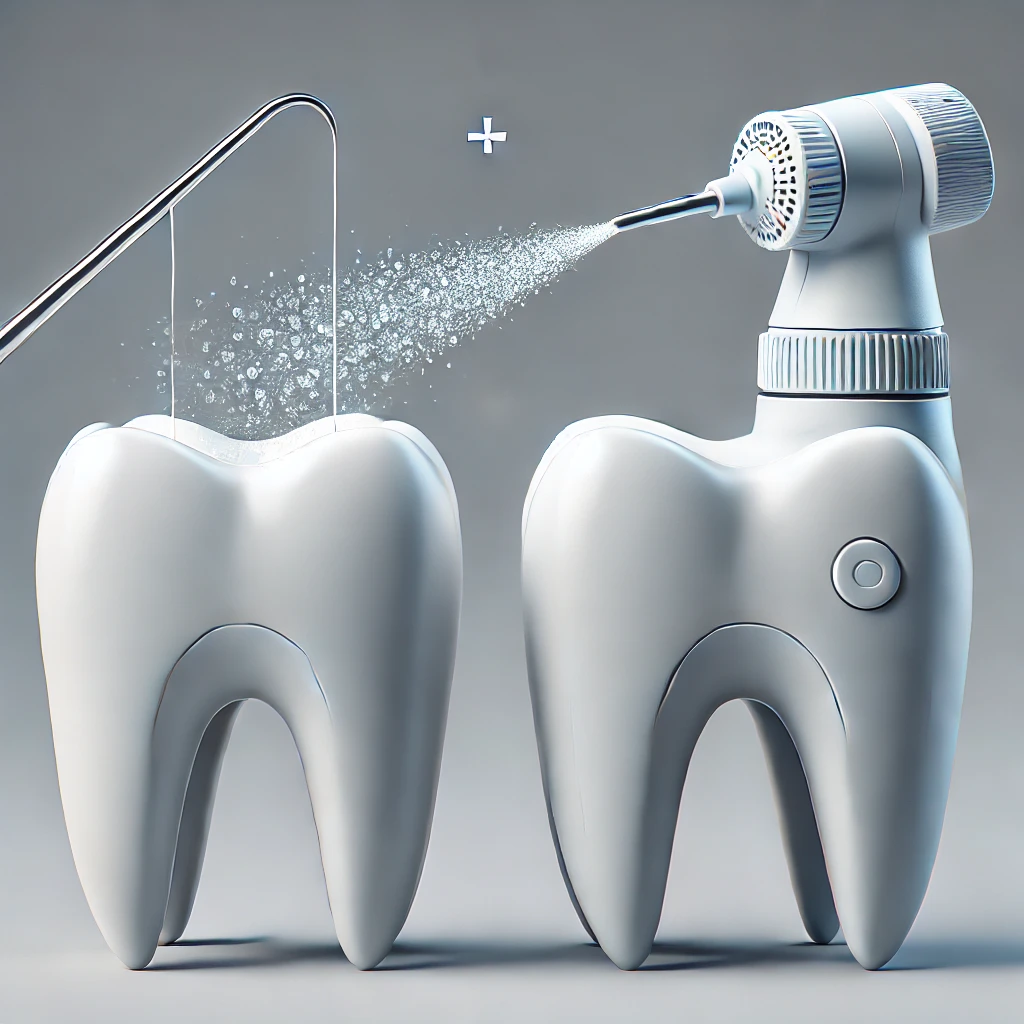Many people have big doubts about which is more effective: Using dental floss or an oral irrigator? We will answer this great question by looking at the main differences between both oral utensils.
What does each one work for?
First of all, let’s see what function each item plays in dental hygiene:
Floss
It is used to clean interdental spaces , removing food debris with a sticky consistency (known as plaque).
It is recommended to floss daily. For it to be effective, you must surround the tooth with the floss in a “C” shape, moving it up and down the side of the tooth and under the gums. However, floss only reaches up to 1-3 mm into the gingival pocket.
If you have gum disease with periodontal pockets larger than 4 mm, regular dental floss will not be able to clean them adequately. It also does not clean the concavities on the sides of the roots of the teeth.
Dental irrigator
Also known as an oral irrigator, this device shoots a stream of water toward the teeth, removing dirt both on the surface and in the spaces between the teeth.
Oral irrigators are a complementary tool to dental floss, but many use them as a replacement. However, they are not designed to prevent cavities, but rather to help prevent gum disease.

What does the dental irrigator provide?
As you can see, both share a common goal: cleaning the spaces between the teeth. Now, in which cases does the irrigator fulfill an irreplaceable function?
This is especially recommended for:
- Orthodontic care .
- People who suffer from bleeding gums .
- Gum inflammation.
- Periodontitis or Gingivitis .
The comparison between water flossers and oral irrigators is an age-old debate. Current scientific research shows that water flossing can clean deeper into the gum pockets in people with periodontal disease.
If you do not suffer from periodontitis, or any of the above conditions, you can continue flossing without any problem.
Cleaning interdental spaces, which is better?
The main use of dental floss is to clean the spaces between the teeth, known as interdental spaces, to remove any food debris.
For some people it can be quite annoying, and if you are not careful, it can tear the gum tissue, damaging it and causing bleeding.
In this respect, the oral irrigator is much more useful, as the jet penetrates between the gaps in the teeth and removes food debris without damaging the tissue. What’s more, it also penetrates the periodontal pockets through the gaps between the gums and teeth, cleaning them of food debris and bacteria.
Can I use the irrigator even if I don’t have dental health problems?
Of course, in fact, although oral irrigators are an “additional” tool, some people find that they don’t need flossing at all.
Using a water flosser is a great way to prevent gum disease, and if you have a dental implant, it will also help prevent peri-implantitis, an inflammatory disease that affects the tissues around a dental implant.
For tooth sensitivity, which is better?
Without a doubt, the irrigator will be a better option than dental floss. Mainly because the jet, at its lowest levels, can produce a massage sensation in the mouth , helping to reduce discomfort.
As if that were not enough, some irrigators include a massage or pulse mode, which makes gum massage much more effective and pleasant. Quite practical for those who suffer from sensitivity.
In addition, it is possible that your gums are inflamed, or due to some disease they are irritated or swollen. If you touch it with dental floss, you would feel a lot of pain.

Always use them as a complement to brushing your teeth.
Now you know how to decide whether you should use a dental irrigator or floss. However, there is one mistake that you should avoid at all costs, no matter what item you use: never forget that dental floss and irrigator are a complement to the toothbrush.
It’s true that the irrigator and floss remove more plaque and food debris than a conventional toothbrush. However, the brush helps to soften the layer of plaque on the surface of the teeth, making it easier to remove with the irrigator and floss.
To achieve the most complete oral hygiene possible, use a toothbrush together with dental floss or an irrigator. You will get the best results after each cleaning, noticing a unique sensation of freshness.
Can both products be used at the same time?
There is no problem in combining them to achieve optimal dental hygiene .
First of all, use the toothbrush to weaken the bacterial plaque film, and then do the same with the dental floss with the food and debris trapped between the interdental spaces.
Next, use the irrigator to clean the surface of the tooth, as well as the spaces between them. And finally, use the mouthwash to rinse your mouth and finish with a pleasant feeling of freshness.
For the cleansing to be effective, remember that after you finish rinsing you should not eat or drink anything for the next 30 minutes.